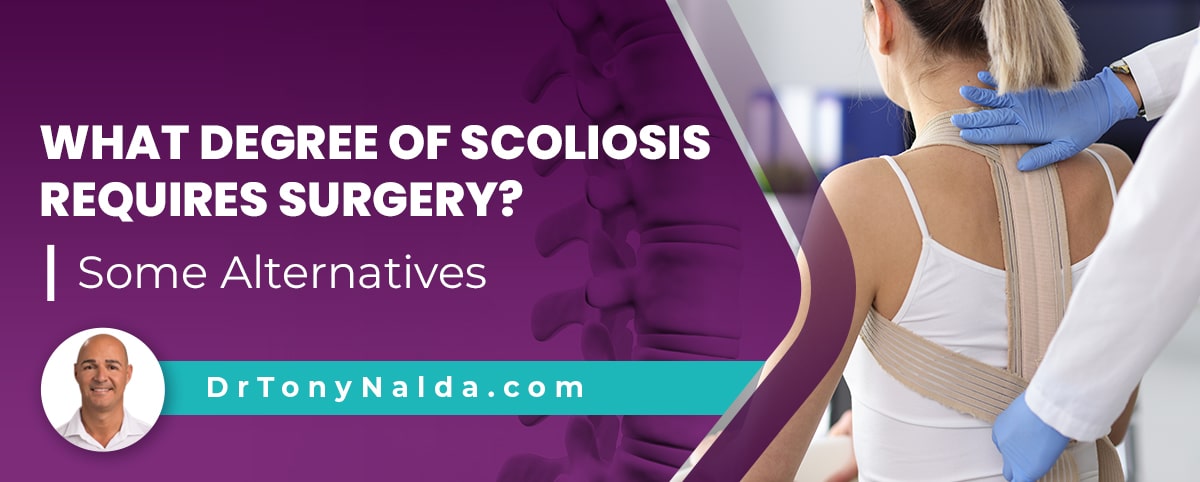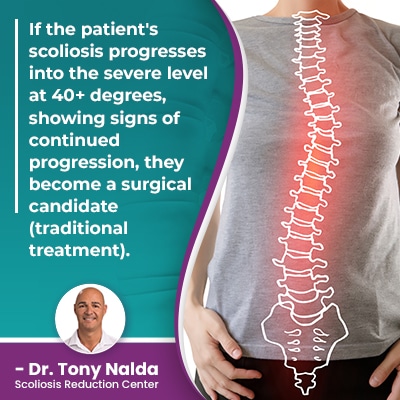What Degree of Scoliosis Requires Surgery? Some Alternatives

There is more than one way to treat scoliosis, and it's important for patients, and their families, to understand the difference because different forms of treatment yield very-different results. Whether or not surgery is required not only depends on a patient's condition, but also what type of treatment approach they have committed to.
Treating scoliosis can involve a conservative chiropractic-centered approach, or a traditional approach with surgical treatment. The reality, however, is that many cases of scoliosis can be treated non-surgically, which is more aligned with the spine's natural movement-based design.
Before exploring the different treatment approaches, let's talk about condition severity, as this is a key factor in surgical recommendations.
Table of Contents
Condition Severity and Cobb Angle Measurement
As such a complex and highly-variable condition, comprehensively assessing conditions so they can be further classified based on important variables is key.
Not only does further classifying scoliosis help streamline the treatment process across different treatment providers, it also informs the crafting of customized treatment plans.
The key classification points are patient age, type, curvature location, and severity; while all of these factors play a role in whether or not a patient receives a surgical recommendation, condition severity is the most important.
When scoliosis develops, an unnatural sideways spinal curve, that also rotates, is present.
When a person's healthy curves are in place, the vertebrae (bones of the spine) are aligned, holding the spine in a straight and neutral alignment, but when an unnatural curvature of the spine develops, it disrupts the biomechanics of the entire spine; the health of each spinal curve is dependant on the health of the others.
A healthy spine has three main spinal curves that characterize each of its three main spinal sections: cervical spine (neck), thoracic spine (middle/upper back), and lumbar spine (lower back).
Cobb Angle
Cobb angle is known as the gold standard in the assessment of scoliosis and is a measurement taken during X-ray.
The measurement involves drawing lines from the tops and bottoms of the curve's most-tilted vertebrae, at its apex, and the resulting angle is expressed in degrees.
A patient's Cobb angle tells me how far out of alignment their spine is, while classifying the condition in terms of severity:
- Mild scoliosis: Cobb angle measurement of between 10 and 25 degrees
- Moderate scoliosis: Cobb angle measurement of between 25 and 40 degrees
- Severe scoliosis: Cobb angle measurement of 40+ degrees
- Very-severe scoliosis: Cobb angle measurement of 80+ degrees
The higher a patient's Cobb angle, the more severe the condition, and the more likely it is that its effects are going to be noticeable.
Before getting to the specifics of how a patient's Cobb angle can factor into whether surgical treatment is recommended or not, let's first touch on another important condition factor: progression.
Scoliosis is Progressive
Another key condition factor that shapes treatment plans is the condition's progressive nature, meaning it's virtually guaranteed to get worse over time.
Patient age really factors into how fast, or slowly, a patient's scoliosis progresses because the condition's trigger for progression is growth and development.
So the age group that are most at risk for rapid-phase progression are adolescents, which helps explain why adolescent idiopathic scoliosis, diagnosed between the ages of 10 and 18, is the most prevalent condition type.
So where a scoliosis is at the time of diagnosis isn't necessarily indicative of where it will stay; scoliosis diagnosed as mild can easily progress to become moderate scoliosis or severe scoliosis, especially if left untreated, or not treated proactively.
Progression is another factor that drives surgical recommendations.
Now, let's address how the two main scoliosis treatment approaches use variables like condition severity and progressive rates to shape their treatment plans.
Scoliosis Treatment Approaches: Traditional vs Conservative
I'll start with the traditional approach to scoliosis treatment because for many years, it was the only treatment option patients were presented with, but this doesn't mean it's the best, or only option.
Traditional treatment can be described as more reactive than proactive, and this is because it doesn't have a strategy for treating scoliosis while mild, so does little to prevent progression; instead, traditional treatment for scoliosis involves a lot of watching and waiting.
For example, if an adolescent diagnosed with mild adolescent idiopathic scoliosis is on the path of traditional treatment, they are commonly told that merely observing for signs of continued progression is all that needs to be done at this stage.
To me, this is wasting valuable treatment time because allowing a progressive condition to progress unimpeded only makes it more complex to treat in the future, reducing the likelihood of treatment success.
The only form of active traditional treatment applied prior to moving on to spinal fusion surgery is traditional bracing, which is associated with a number of shortfalls, mainly because it only addresses scoliosis as a 2-dimensional condition, ignoring its rotational component that makes it a complex 3-dimensional condition.
 If the patient's scoliosis progresses into the severe level at 40+ degrees, showing signs of continued progression, they become a surgical candidate (traditional treatment).
If the patient's scoliosis progresses into the severe level at 40+ degrees, showing signs of continued progression, they become a surgical candidate (traditional treatment).
Now, spinal fusion surgery, like all surgical procedures, is risky, but spinal surgery in particular is invasive, costly, and can end up costing the spine in terms of its natural strength, flexibility, and function, which can greatly impact overall quality of life.
Fortunately, there is a more modern and natural treatment approach, with proven results, showing that many cases of scoliosis can be treated successfully without the risks of scoliosis surgery.
Conservative Chiropractic-Centered Treatment for Scoliosis
Here at the Scoliosis Reduction Center, my patients benefit from a conservative chiropractic-centered treatment approach that strives to preserve as much of the spine's natural strength and function as possible, by helping patients avoid spinal fusion surgery.
If I was to diagnose an adolescent with mild adolescent idiopathic scoliosis here at the Center, I would start treatment as close to the time of diagnosis as possible: this is being proactive.
While there are no treatment guarantees, through starting treatment for scoliosis early in its progressive line, there are fewer limits to what can be achieved.
As scoliosis progresses, this means the unnatural spinal curvature is increasing in size, as are its effects as the spine and its surroundings are exposed to more and more uneven forces.
As a scoliotic curve gets larger, it becomes more rigid, making it less responsive to treatment, and as the muscles that surround the spine play a role in maintaining the healthy spinal curves by providing it with support, these muscles are also affected by uneven forces.
What can happen is the more scoliosis progresses, the more unbalanced the spine's surrounding muscles become, with muscles on one side of the curve becoming stretched and loose from overuse, and muscles on the opposite side becoming weak from underuse.
 It's far simpler to work towards proactively preventing escalating symptoms of scoliosis and condition effects, than attempting to reverse them once they've developed.
It's far simpler to work towards proactively preventing escalating symptoms of scoliosis and condition effects, than attempting to reverse them once they've developed.
So what exactly does conservative chiropractic treatment options involve? Integrating multiple condition-specific treatment disciplines can impact conditions on every level, which is precisely what the complex nature of scoliosis necessitates.
Chiropractic Care
Chiropractic care is key to reducing a scoliosis curve because as a structural condition, scoliosis has to, first and foremost, be impacted on a structural level.
Through a series of chiropractic techniques and manual adjustments, I can work towards adjusting the position of the most-tilted vertebrae of the curve back into alignment with the rest of the spine, thereby restoring as much of its healthy curves as possible, and reducing the condition's uneven forces alongside the curvature size.
Physical Therapy
When traditional scoliosis treatment options were the dominant choice, the place of exercise in scoliosis treatment was questioned, but we have since learned that when combined with other forms of corrective treatment, it can help take pressure off the spine by strengthening its surrounding muscles so they can provide optimal, and much-needed, spinal support and stabilization.
In addition, physical therapy and scoliosis-specific exercises (SSEs) can help improve brain-body communication for improved posture and body position, which greatly affects the spine, and physical therapy can also address, or prevent, related muscle imbalances.
Corrective Bracing
Corrective bracing addresses the shortfalls associated with traditional bracing by offering corrective results and addressing the condition's true 3-dimensional nature.
Corrective braces, like the ScoliBrace, can augment corrective results worked towards through other treatment disciplines by pushing the spine into a corrective position.
Rehabilitation
Once I've achieved a significant curvature reduction and increased core strength to ensure the spine is receiving what it needs from its surrounding muscles, it's time to work on rehabilitating the spine.
Through a series of custom-prescribed scoliosis-specific exercises and stretches, I can help patients work towards establishing a home-rehabilitation program to further stabilize the spine for long-term sustainable treatment results.
Conclusion
So for those receiving a surgical recommendation and wondering if surgery is required or not, that will depend on the chosen treatment approach.
For those on the path of traditional scoliosis treatment, once a patient crosses into the severe classification at 40+ degrees, and shows signs of continued progression, they are considered surgical candidates.
While spinal fusion surgery can help straighten a scoliotic spine, the way this is achieved, through fusing two or more vertebrae into one solid bone and attaching metal rods to the spine with screws to hold it in place, is not the same as achieving corrective results through a more natural form of treatment.
The reality is that many cases of scoliosis don't require surgical treatment, so for those who choose to forgo a recommendation for surgical treatment, or who simply want to try a less-invasive treatment option first, a conservative chiropractic-centered treatment approach has proven results showing surgical correction is neither the best, nor the only, way to address an abnormal curvature of the spine.
Dr. Tony Nalda
DOCTOR OF CHIROPRACTIC
After receiving an undergraduate degree in psychology and his Doctorate of Chiropractic from Life University, Dr. Nalda settled in Celebration, Florida and proceeded to build one of Central Florida’s most successful chiropractic clinics.
His experience with patients suffering from scoliosis, and the confusion and frustration they faced, led him to seek a specialty in scoliosis care. In 2006 he completed his Intensive Care Certification from CLEAR Institute, a leading scoliosis educational and certification center.
About Dr. Tony Nalda
 Ready to explore scoliosis treatment? Contact Us Now
Ready to explore scoliosis treatment? Contact Us Now





